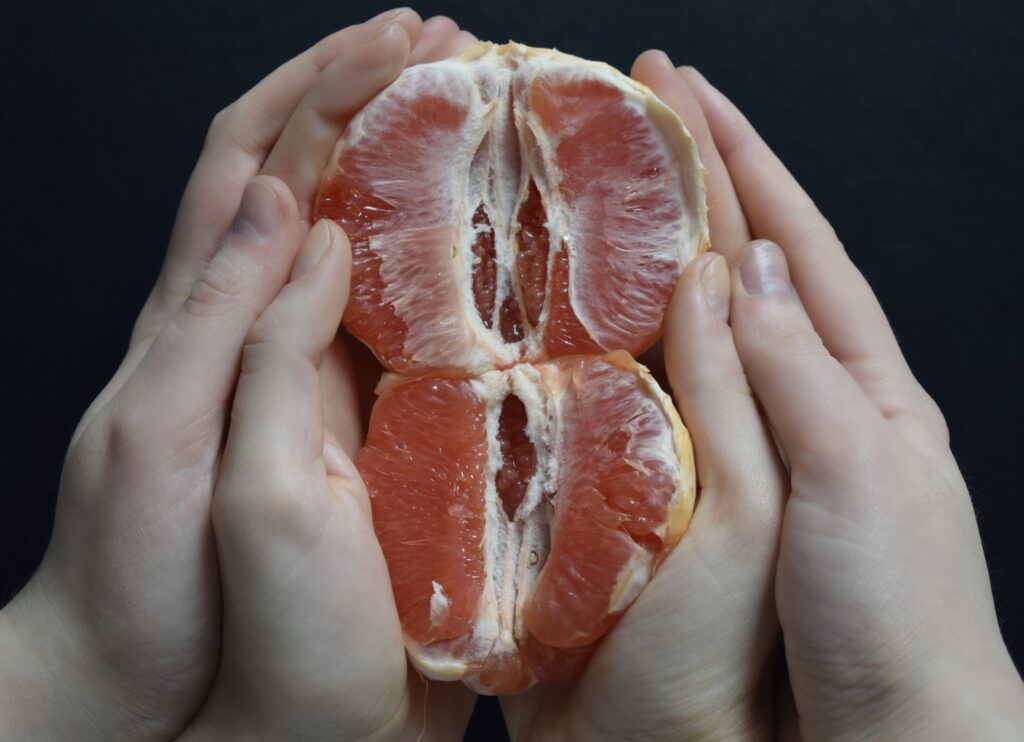An IUD destroyed my sex life and sent me searching for answers. If painful sex is a reality for many, why aren’t doctors providing solutions?
BY EMILY CLARE ELLIOTT
PHOTOGRAPHY BY CHIARA GRECO
———————————————————–
Trigger warning: this article discusses sexual violence and may be triggering for some readers.
As I sat on the clinic table, with the crinkly paper growing damp beneath my bare, sweaty legs, I looked into my gynecologist’s beady eyes and angrily thought to myself, this woman should not be allowed to practice medicine. A few weeks prior, I had been sitting on the same clinic table, with the same crinkly paper, the same beady eyed gynecologist, and my feet in stirrups. I was awash with feelings of ease and excitement. I sat in hopeful anticipation, feeling mentally prepared to receive my first ever intrauterine device (IUD). Little did I know the routine procedure would impact my life in the worst way imaginable.
The first appointment was nothing short of hell. My doctor, a pretty young thing with an affinity for IUD insertions, had assured me I would suffer exactly 90 seconds of excruciating pain in exchange for one of the most effective birth controls on the market. Instead, my uterus refused the IUD’s entry. I left the appointment feeling angry and traumatized. I had paid my price in pain, so where was my reward? At the time, I was uneducated in the contraception domain. I opted for an IUD to help balance my mental health, which had deteriorated as a result of the birth control I had been taking for about six years. Without doing any extensive research, I came to the decision that an IUD would be the ideal method for me. When I made an appointment with my gynecologist, I asked for an IUD instead of having a conversation regarding my options.
In hindsight, I feel as though my pain was neglected. Rather than informing me of the alternative options that were readily available to me, I was prescribed a muscle relaxant and instructed to return a week later for my doctor to attempt to insert the device for a second time. During this appointment, my doctor applauded my pain tolerance as she pushed through my cervix to allow the IUD to be placed correctly at the top of my uterus. The clinic room I once felt so excited to sit in, I returned to feeling defeated. Less than a month after suffering the worst pain I had ever experienced, I was desperate to find relief. Despite having my IUD removed a few weeks prior, I was still experiencing extreme levels of discomfort.
“As I learned this new way of living, I began to recognize that my issues ran deeper than the neglect of one gynecologist.”
My gynecologist uttered the word “dyspareunia” with a look of regret on her face. A hypochondriac by nature, I felt my heart race and stomach churn—flashes of worst case scenarios flickered through my mind. I saw a life where discomfort and pain overruled pleasure. Once the panic subsided, fury set in. I had researched the term prior to my appointment, and I knew what this damning diagnosis meant for me. “Dyspareunia,” defined as persistent or recurring pain felt in the genitals before, during, or after sexual intercourse, meant that I would have to develop a brand new relationship with my reproductive organs. As a direct result of the trauma I experienced with my IUD, I now felt unrelenting pain—from sitting cross-legged to going to the bathroom. Sex, which was the main reason why I opted for birth control to begin with, was now completely off the table.
During my diagnosis, I was taught to care for my body in ways I never had to before. Painful intercourse was new for me, but for a surprising number of people this is their normal. As I learned this new way of living, I began to recognize that my issues ran deeper than the neglect of one gynecologist. There is a lack of education and awareness for young females, or people assigned female at birth, regarding how sex is supposed to feel. Many do not reach out for help when they experience vaginal discomfort. And even when they do, their pain is often taken less seriously by medical professionals in comparison to men. Research suggests that physicians often assume that women’s pain is psychosomatic more frequently than with men. Consequently, women are often made to feel the pain they experience is either an exaggeration or psychological in nature, which may stall or derail their ability to seek and receive proper diagnosis and treatment.
New Conversations with Friends Part One: Lucia
If resiliency was personified, Lucia would be it. (Lucia asked not to be identified by her real name.) We met each other in residence during our first year at Queen’s University in Kingston, Ontario. We often studied together during exam season or frequented the local bars. When Lucia transferred schools, we remained friends through occasional FaceTime calls and by keeping each other updated on important life events. So when I decided to write this article and began searching for people to share their stories with me, I was surprised when she reached out and expressed interest in being a source. Throughout six years of friendship I never knew she suffered from dyspareunia.
At 24, the petite and witty blonde sat in her room in St. Catharines in front of her laptop. Although we have had many phone calls over the years, this one felt different. Regardless, the conversation flowed easily as she confessed that her pain had been long-lasting. For Lucia, dyspareunia is the result of multiple factors, all of which have caused her to develop a negative relationship with sex. Since her first period at age 13, which lasted two weeks, Lucia has searched for the solution to her pain. “I feel like I have always had problems with reproductive health in general,” she says. Though the topic is grim, she dons a bright smile.

During our interview, I feel grateful to be privy to this sensitive side of my friend, and although our discussion is breaching new territories, the conversation moves smoothly. I watch as she ponders the traumas and complications that she has faced as well as the lack of support she has received from medical professionals. As she takes another sip of white wine, she explains her experience with receiving an IUD. “I literally said, ‘I don’t think I can do this,’” she recalls. The doctor had ignored her protests and continued to insert the device.
“Lucia recalls moments during sex where she would be in physical pain while simultaneously reliving the events of her assault.”
Lucia has asked medical professionals countless times to answer her questions about why sex has always been painful. The consensus seems to be endometriosis—a condition where the endometrial-type tissue that lines the uterus grows outside of it, which can cause pelvic pain, bad menstrual cramps, and discomfort during sex. While Lucia’s doctors mentioned a test that would confirm this diagnosis, they never pursued it. She is frustrated and her anger is palpable. “It’s weird because it’s mine,” she says, referring to her body. “To not understand it is very scary.”
As if recalling a distant bad memory, Lucia reveals that dyspareunia has been with her since the beginning of her sex life, but she adds that her symptoms worsened after experiencing a sexual assault during her first year of university in 2016. She says she feels entrapped by the trauma and its lasting effects on her mind and her body. Although today she’s learned to manage it better, after the assault, sex became a traumatizing and painful experience for her. Lucia recalls moments during sex where she would be in physical pain while simultaneously reliving the events of her assault. Despite being reduced to tears, she would urge her partner to continue.
In the instances where sex didn’t trigger Lucia’s PTSD, dyspareunia would prevent her from enjoying the experience regardless. She says it felt like her body from the waist down had a mind of its own. “What I was thinking was not at all what my body was doing. I could feel my body tightening and clenching and rejecting everything I wanted.” Although there are options available for treatments, for a time, the barriers that Lucia faced left her feeling drained and unwilling to pursue further medical assistance.
New Conversations with Friends Part Two: Willa
Willa Morton’s fireplace mantle is decorated with city-owned memorabilia that were undoubtedly brought home during wild nights out on the town. Morton flicks a stray ant that roams on the couch beside her, and it lands right on my lap. Although I let out a small squeal in fright, she remains unphased. She is a 22-year-old student studying psychology at Queen’s University. For Morton, sex has always been painful. “As long as I can remember, I have had pain. Like, deeper pain. Before I was even sexually active, around probably age 13,” she says. “So, when I first got my period and I had to use products, I would only use pads for a while, just because I was afraid of inserting anything.”
“She refrained from disclosing her pain to partners, secretly hoping that if she could hide the discomfort well enough, she could hide it from herself too.”
Morton describes herself as a very sexual person, but because of the pain she feels during sex, she feels like she can’t be her true self. When she first began exploring sex, she was under the impression that pain was inevitable and unavoidable. She refrained from disclosing her pain to partners, secretly hoping that if she could hide the discomfort well enough, she could hide it from herself too. “I almost try to convince myself that I don’t have this problem, just because I don’t fully understand it,” she says. “Before I met my first boyfriend, I had basically given up on ever thinking that I could enjoy sexual intercourse.”
At 17, Morton sought medical help to find solutions for her pain. These interactions were mediocre at best. Morton says one gynecologist she met seemed understanding at the moment, but she left the appointment without any referrals or direction on how or where to get further help for her condition. She eventually realized that the cause of her pain was vulvodynia—chronic vulvar pain that is sometimes used interchangeably with dyspareunia, although it has its own classification under the umbrella of genital pain. Morton feels that the lack of education about sex has made her experience isolating. “I was never really prepped to ever feel this pain or discomfort,” Morton says, “so when it was happening to me, I felt super alone. I felt like I couldn’t tell anyone about it.” Sex should feel liberating and enjoyable for all parties involved. But for many living with chronic genital pain, sexual satisfaction is often impossible while experiencing this type of discomfort. “If I’m feeling pain, there is no way I’m feeling pleasure.”
Steps Forward in Health Care: Pelvic Floor Therapy
Dr. Veronica Legnini, a family physician in Kingston, Ontario, prioritizes asking patients during pap smears about any discomfort. “It’s very rare for people to come in and say, ‘sex is painful, help me with it,’” Legnini says. “Because of the taboos around sex, particularly women’s pleasure, it’s kind of bottom of the heap.” For those who experience pain during sex, sometimes their first point of contact in the medical system is their family doctor. Having a medical professional who is asking the correct questions is imperative to reaching a diagnosis and providing solutions.
This may be especially challenging for trans men and non-binary people who can also suffer from dyspareunia. A 2022 study published by LGBT Health found that trans men experienced a higher prevalence of dyspareunia in comparison to the general population. Yet the subject has been granted little research, and there are known problems in care team competence when it comes to trans healthcare. Many trans people experience challenges finding physicians who are knowledgeable about trans health, and negative experiences in health care foster distrust of the medical system generally. As a result of these factors, it’s not uncommon for gender non-conforming people to delay care when they experience pain. This means that many instances of dyspareunia experienced by trans men and non-binary individuals are likely not being recognized by medical professionals, which widens the gap in our knowledge about how this condition affects them.

Some medical professionals are, however, invested in finding relief for people suffering from dyspareunia. One example is pelvic floor therapy. Rachel Coens, a physiotherapist in Kingston, has been practicing pelvic health care since 2017. Coens’ services are meant to help women, trans, and non-binary folks learn more about their bodies. This involves discovering what might be contributing to their pain and discomfort, seeing if there is any manual work that can be done in-clinic, and giving clients self-management strategies, exercises, or self-myofascial care (deep tissue massages). Coens also sees a lack of awareness regarding dyspareunia among the general public—many patients who find themselves in her office are usually there for reasons other than chronic pelvic pain. The diagnosis often comes after a physical exam and overview of their medical history, where clients describe their pain. Coens uses a biopsychosocial approach with her treatments, which looks at the patient’s physical health, psychological health, and external factors such as personal relationships and socioeconomic status.
Coens believes there is progress being made in the medical field for doctors dealing with women’s pain. “I would say 10, 15, even 20 years ago, a family doctor might have just said, ‘Oh, just try more lube’ or, ‘It’s par for the course if you’re not the same size as your partner,’ whereas now, they’re becoming a better referral source for sending people to see a physio and an OBGYN.” Coens says that seeking help for pain with penetration or genital pelvic pain is becoming less taboo. While this might be true for some, women like Lucia and Morton are still experiencing pain with intercourse and facing barriers at every step of the journey.
Steps Forward in Health Care: Chronic Genital Pain Research
In the early to mid-1990s, a bright-eyed Caroline Pukall was starting her undergraduate degree in psychology at McGill University in Montreal. It was there that her research on vulvodynia began. “The feminist inside me was enraged that women’s pain was being invalidated,” she says. Vulvodynia is chronic pain that occurs in specific areas of the vulva and often involves a burning or stinging sensation. When Pukall first entered the field of psychology as a clinician and researcher in the early 2000s, genital pain was often discounted and attributed to psychological factors or a psychosomatic response. Pukall thought that “somebody needs to actually do something to say that, even though you can’t really see what’s causing the pain, the pain is actually present.”
“While women, trans, and non-binary people face barriers outside the healthcare system such as stigma, invalidation of pain, and lack of proper sexual education, they might face even more once they seek professional help.”
Pukall acknowledges the common spread of misinformation regarding sex for people with vaginas, specifically the assumption that sex is supposed to be painful. She says research has shown that, on average, patients are waiting five years for a diagnosis. Pukall explains that an efficient diagnosis depends on whether physicians have adequate education on vaginal pain, if they’re comfortable with discussions about sexual health, and whether they can make helpful referrals. While women, trans, and non-binary people face barriers outside the healthcare system such as stigma, invalidation of pain, and lack of proper sexual education, they might face even more once they seek professional help. The result of this flawed system, Pukall says, could ultimately worsen the situation. “It becomes a protracted cycle of waiting, during which the pain perpetuates and starts to get worse, because now everything else is being affected. The person’s sense of self, their sexual self-esteem—all of that comes into play the longer a person [suffers]. Not everybody, but certainly the majority.”
Pukall places a particular importance on giving people who experience vaginal discomfort accessibility to answers. While there is no “quick fix,” there are resources available. “You are worth the work it takes to get that pain solved.”
Closure
I grew up in a Catholic household and attended Catholic schools. My sex education was minimal at best. I recall learning about female and male anatomy, perhaps a lesson on slipping a condom on a banana. Abstinence, we were told, was the best method for avoiding STDs and unwanted pregnancies. It would be years until I could embrace my sexuality and speak openly with my parents, friends, and even my partners about anything sexual.
Now, experiencing problems with my sexual health, I am finally able to be open and honest with the people in my life. I spoke with my mother about the health concerns I was facing without the fear of judgement, which resulted in support and helpful advice. I also spoke with my friends about the physical pain I was experiencing and how it negatively affected my mental health. It was so helpful to not navigate this difficult experience alone.
“Having previously experienced intimacy without pain helped me understand that something was deeply wrong when I did begin experiencing symptoms.”
Intimacy with my partner changed drastically after I developed dyspareunia and his patience and empathy helped me work through a lot of my pain. Eventually, we got to a point where intercourse was back on the table. My partner understood the depths of my agony and took the time to love me through all of it.
Having previously experienced intimacy without pain helped me understand that something was deeply wrong when I did begin experiencing symptoms. Dyspareunia is not always caused by trauma, and for some people, they have nothing else to compare it to when feeling discomfort during sex. Interestingly, in each conversation I had with medical professionals and women with dyspareunia, one statement kept recurring: “In school we are taught that sex is supposed to hurt.” Every single woman I spoke with said these words. Doctors said these words. With each conversation, I grew angrier. I was angry that penetration and pain were being taught as synonymous. I felt sad for the people who were taught that their pain is normal, and have yet to discover the resources available to them.

Months after my initial appointment for my IUD, I returned to the same office with the same crinkly clinic paper and the same nauseating fluorescent lighting. This time, however, I had my pants on. I stuffed the anger I was feeling deep inside my gut as the young, bubbly doctor bounced into the room. “Oh, you’re going to hate me after you see how easy this is!” I recall her beaming as she referred to the rod that was about to be placed into my arm. Nexplanon is a small contraceptive implant that is placed in the non-dominant upper arm. For me, it was a far less painful and invasive, yet still effective, method for birth control. To this day, I still hear her words ringing in my ear, and my anger resurfaces. It had taken two failed IUD insertions to finally be given alternative options for contraception. It was also an option that did not risk permanent, life-altering changes to my body. I still don’t know why it was never brought up during my initial assessment.
Recently, I met up with a friend for a spa date. As I watch the nail technician polish up my french tips, I turn to look over at my friend sitting next to me, my nose adjusting to the fumes of acrylics and nail polish remover around me. Our conversation had covered everything from boy drama to school assignments to holiday season chaos. She flicks her hair behind her shoulder and, with a bright smile, tells me about her most recent life update: her plans to get an IUD. I feel my heart start to quicken. I let her finish before I tell her about my failed IUD insertion, the pain I’ve endured because of it, the small rod in my arm and how it has worked for me. She takes a moment to process what I’ve said, then admits that she didn’t know much about alternative options. I encourage her to do more research before her IUD appointment, and she agrees. I tell her my own story, and about other forms of birth control, because what happened to me was preventable—and because I fear that if I didn’t, no one else would.

